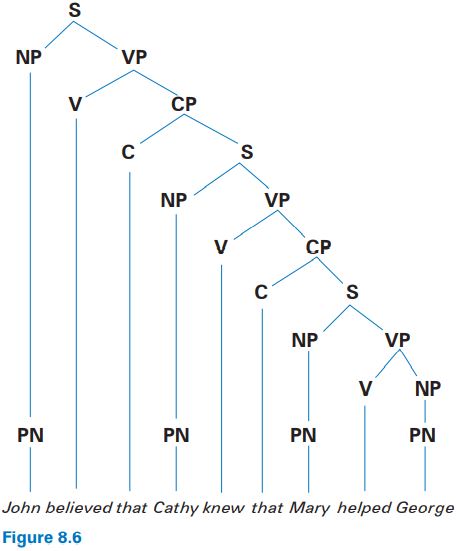
Complement phrases
 المؤلف:
George Yule
المؤلف:
George Yule
 المصدر:
The study of language
المصدر:
The study of language
 الجزء والصفحة:
105-8
الجزء والصفحة:
105-8
 17-2-2022
17-2-2022
 4112
4112
The word that, as used in these examples, is called a complementizer (C). The role of that as a complementizer is to introduce a complement phrase (CP). For example, in the second sentence (Cathy knew …), we can identify one CP which contains that plus Mary helped George. We already know that Mary helped George is a sentence (S). So, we are now in a position to define a CP in the following way: “a complement phrase rewrites as a complementizer and a sentence,” or CP → C S.
We can also see from the same sentence that the complement phrase (CP) comes after a verb (V) knew. This means that we are using the CP as part of a verb phrase (VP), as in knew that Mary helped George. So, there must be another rule that says: “a verb phrase rewrites as a verb and complement phrase,” or VP → V CP. If we now look at these two new rules in conjunction with an earlier rule, we can see how recursion is built into the grammar.

We begin with S on the left and, as we rewrite symbols, we eventually have S on the right, allowing us to go back to the beginning and go through the set of rules again (and again). This means that we can, in principle, use these rules to create an endless sentence containing other sentence structures. In practice, it allows us to draw the following tree diagram and provide a clear representation of the syntactic structure of this one fairly complex sentence.

As we try to capture more aspects of the structure of complex English sentences, we inevitably need to identify more rules and concepts involved in the analysis of syntax. (We’ve barely scratched the surface structures.) However, having explored some of the basic issues and methods of syntactic analysis in order to talk about structure in language, we must move on to consider how we might incorporate the analysis of meaning in the study of language.
 الاكثر قراءة في Syntax
الاكثر قراءة في Syntax
 اخر الاخبار
اخر الاخبار
اخبار العتبة العباسية المقدسة


